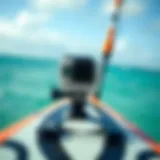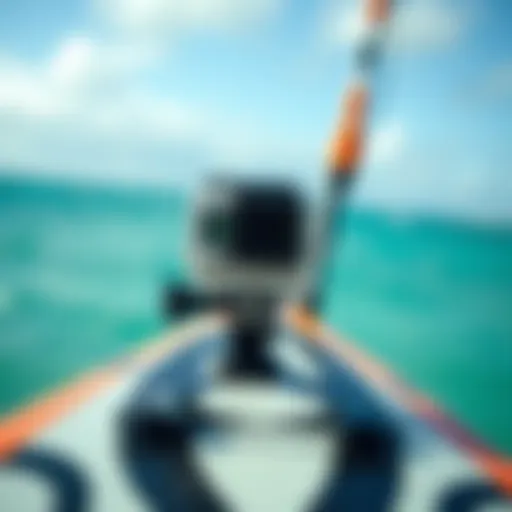Kitesurfing Lessons in San Francisco: Your Complete Guide
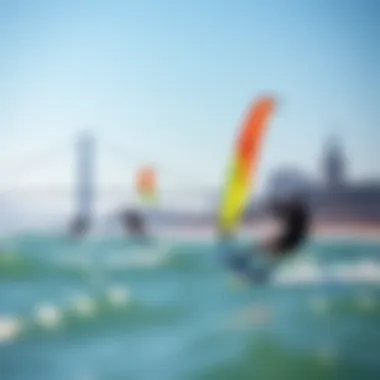
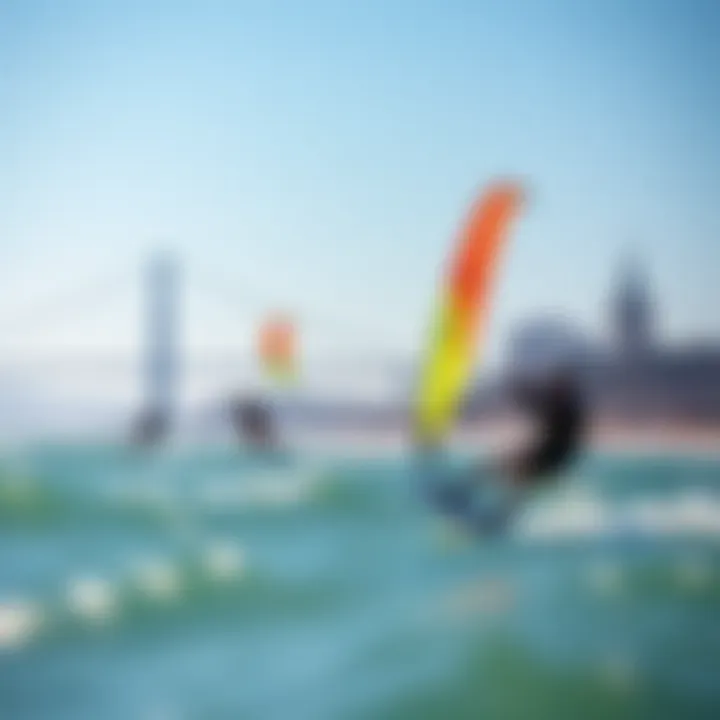
Intro
Kitesurfing is more than just a pastime; it’s an exhilarating blend of skill, nature, and adrenaline. In San Francisco, where the winds are favorable and the ocean beckons, learning the ropes of this sport is a thrilling adventure waiting to unfold. This guide explores the extensive kitesurfing lessons available in the city, whether you’re a curious novice or a seasoned rider looking to polish your skills.
The Bay Area offers unique conditions that make it a hotbed for water sports, and kitesurfing is no exception. With the majestic Golden Gate Bridge in the backdrop and waves that call out to ride them, the scene here is picturesque. Yet, diving into the world of kitesurfing requires proper instruction and understanding of essential elements—hence, this article is meticulously tailored for kiteboarders, instructors, enthusiasts, and event organizers. We'll explore the gear selection, skill development, and the local nuances that determine the best learning experiences. Stay tuned as we navigate through each facet of kitesurfing lessons in San Francisco, ensuring you have a roadmap to kickstart or enhance your kiteboarding journey.
Preamble to Kitesurfing in San Francisco
Kitesurfing has gained quite the traction over the past couple of decades. It’s not just a sport anymore; it has become a lifestyle for many living near the coast. San Francisco, with its stunning landscapes and lively culture, stands out as a prime location for kitesurfing. This section aims to underline the essential aspects of kitesurfing in the city by the bay.
The first thing to grasp is the vibrant community that surrounds this sport. The blending of outdoor adventure with a social atmosphere makes it appealing to both newbies and seasoned veterans. Here, you'll find a mix of people from all walks of life sharing the joy of harnessing the wind. The influx of schools offering lessons means that newcomers can quickly get their feet wet—sometimes literally.
Another crucial aspect is how San Francisco's unique geographical features influence the kitesurfing experience. The varied winds and changing tides create opportunities for both challenge and excitement, making it a training ground unlike any other. Understanding these local elements not only enhances skills but also deepens appreciation for the sport.
As we dive deeper into our guide, we will cover various aspects you should be aware of, including popular schools to consider, necessary equipment, and environmental factors. This guide will aim to enrich your experience and ensure that you enjoy not just the thrilling moments, but also the journey that this exhilarating sport offers.
The Rise of Kitesurfing as a Popular Sport
Kitesurfing has seen a meteoric rise in popularity over the years. This surge can be attributed to a combination of factors. First off, it’s thrilling. The rush of being powered by the wind while skimming across the water speaks to the thrill-seekers among us. The evolution of kite technology has also played a major role; with better designs and materials, it has become accessible to more individuals.
Moreover, social media has significantly contributed to its growth. Stunning visuals of kitesurfers in action, captured on smartphones and shared on platforms like Instagram and Facebook, have ignited interest globally. The captivating images make you see not just the sport, but also the lifestyle that comes with it.
The buzz around competitions and events also fuels this rise. Events such as the GKA Kite World Tour draw attention from both competitors and spectators, amplifying interest in kitesurfing as a legitimate sport. This creates a cycle where enthusiasts are inspired to take up kitesurfing after seeing others engaging, further driving its popularity.
Unique Characteristics of San Francisco’s Waters
San Francisco’s waters offer a myriad of challenges and features that make it specially suited for kitesurfing. First, let’s talk about the winds. The infamous San Francisco Bay wind patterns, often dictated by the local topography and ocean currents, create a reliable and consistent wind flow, which is ideal for novice and experienced kitesurfers alike.
When it comes to the water conditions, the mix of cold ocean currents and the warmer bay water leads to interesting challenges. These shifts can change how a kite reacts, allowing for a different learning experience each time you hit the water. Furthermore, the city has varying locations—some with large swells while others are flatwater spots—catering to different skill levels.
Wildlife interactions are another important aspect. Recognizing that you might share the waters with diverse marine life, including local seals and birds, adds an additional layer to the experience. Respecting these creatures is critical, as they are an essential part of the bay’s ecosystem and enhance the overall adventure.
Choosing the Right Kitesurfing School
Selecting a suitable kitesurfing school is crucial for anyone eager to delve into this exhilarating sport. Not all schools are created equal; the right one can make a world of difference in terms of safety, skill development, and overall enjoyment. When embarking on this journey in San Francisco, the options can feel overwhelming, but understanding the unique offerings of different schools can streamline the selection process.
A quality school not only provides instruction but also fosters a community of like-minded enthusiasts. This can enhance the learning experience significantly. You want to feel comfortable and supported as you loearn, and a friendly atmosphere can ease anxieties. Furthermore, schools often have different teaching philosophies, so matching your learning style with the school’s approach is essential.
Also, consider the instructors’ qualifications. Experienced instructors can guide students through the nuances of kitesurfing with the right focus on safety and skill progression. When you’re out on the water, knowing that an expert guides you can bring peace of mind.
"Finding the right kitesurfing school is like finding the right pair of shoes; they should fit well and support you every step of the way."
Key Factors in Selecting a School
When it comes to picking a kitesurfing school, there are several key factors to keep in mind:
- Location: Proximity to suitable kitesurfing spots is vital. San Francisco offers various beaches, and the right school should ideally be close to locations with favorable wind and water conditions.
- Lesson Offerings: Some schools might specialize in beginners, while others offer advanced training. Determine your skill level and make sure the school caters to it.
- Instructor Qualifications: Research the instructors' backgrounds. Certifications and experience can make a significant difference in your learning experience.
- Equipment Availability: Quality equipment is paramount. Ensure the school provides well-maintained gear that fits your size and skill level.
- Student-to-Instructor Ratio: Smaller class sizes typically mean more personalized attention, enhancing the learning process.
Top Kitesurfing Schools in San Francisco
School A: Overview and Offerings
One of the premier options is "Kite Surfing Adventures". Specializing in beginner lessons, it emphasizes a hands-on approach, ensuring that students receive plenty of water time. The school's location, near Crissy Field, is advantageous due to its consistent winds and stunning views of the Golden Gate Bridge.
A defining characteristic of Kite Surfing Adventures is its commitment to safety. They insist on using only high-quality gear, which is crucial, especially for novices. This dedication to equipment and instruction has made it a popular choice among newcomers. However, during peak season, classes can fill up quickly, so it’s wise to book in advance.
School B: Overview and Offerings
Next is "Wind Warriors", known for its more advanced programs tailored for seasoned riders wanting to take their skills to the next level. They offer unique training that includes freestyle tricks and technique refinement, making it a go-to option for those seeking to elevate their game.
Wind Warriors is celebrated for the experience level of their instructors, many of whom are competitive kitesurfers themselves. This can significantly enhance the learning process. However, their focus on advanced techniques means that beginners might feel out of their element.
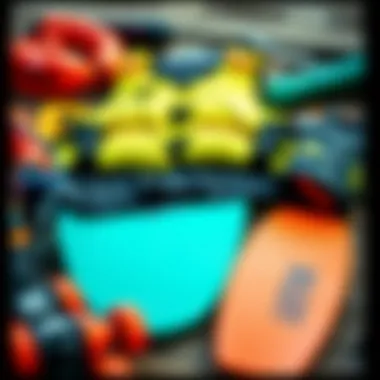
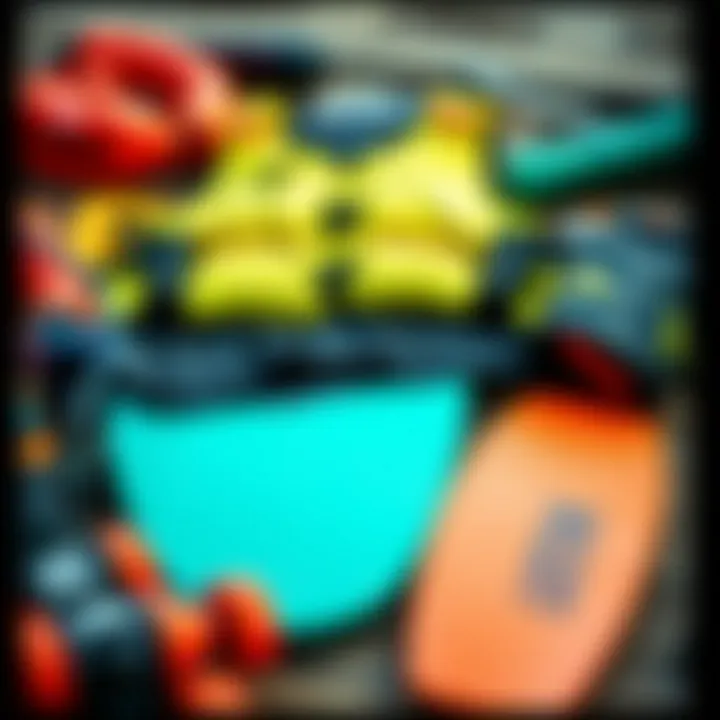
School C: Overview and Offerings
Finally, "Bay Area Kite School" offers a well-rounded curriculum for all levels. What sets them apart is their flexible scheduling and personalized lesson plans. They provide private consultations before lessons to cater their approach to the student’s unique needs.
Bay Area Kite School’s instructors are patient and enthusiastic, which creates a comfortable environment for learners. On the downside, their human resource is limited, meaning availability may vary throughout the week. Despite this, many students return year after year, thanks to the engaging community and effective lessons they provide.
Choosing the right school can significantly enrich your kitesurfing experience in San Francisco. With a little research, students can match their goals with the right environment and instructor, setting the stage for a rewarding and exhilarating journey.
Lesson Structures and Techniques
Understanding the frameworks and methods behind kitesurfing lessons is crucial for anyone looking to dive into this thrilling sport. The right lesson structure not only facilitates learning but also ensures that students develop the necessary skills safely and effectively. A variety of formats exist to cater to different learning styles, making it essential to choose a structure that aligns with your goals and disposition. The flexibility in technique offers numerous benefits; whether you're a hands-on learner or prefer group engagement, there’s a format suited for everyone.
Typical Lesson Formats
Private Lessons
Private lessons are tailored experiences where one student works closely with an instructor. This individual attention is a significant aspect of private lessons. What sets this format apart is its customization—lessons can be adapted to the student's pace and skill level. Students benefit from focused guidance, allowing them to hone specific skills without the distraction of others. The instructor can tailor the session, spending more time on areas that require improvement. Moreover, private lessons offer the luxury of scheduling flexibility, which is often desirable for busy individuals. However, this format can come at a higher cost compared to group sessions.
Group Lessons
Group lessons bring together multiple students, often from varied backgrounds and skill levels. This format fosters a sense of camaraderie. One of the key features of group lessons is the built-in support system; students often encourage each other, which can ease the learning process. They also tend to be more affordable than private sessions since the costs are shared among participants. However, the downside might be the varied pace of learning—advanced students may feel the need to wait for slower learners, while beginners could feel overwhelmed by the more experienced members in the group.
Introductory Clinics
Introductory clinics are an excellent avenue for those who want to dip their toes into kitesurfing without a full commitment. These clinics typically last a few hours or a day and serve as a primer for the sport. They often cover essential basics and provide an opportunity to try out equipment and techniques in a relaxed setting. A key characteristic of these clinics is that they are designed to give a taste of kitesurfing, making them accessible to a wider audience. However, because they are introductory by nature, they might not delve into the depths of technique or safety that full lessons would provide, leaving some participants hungry for more in-depth learning.
Skills Covered in Initial Lessons
Initial kitesurfing lessons focus on developing a solid foundation for newcomers. These sessions typically include theoretical knowledge about equipment, understanding wind patterns, and learning how to control the kite properly. Participants can expect to cover vital skills such as launching and landing the kite, body dragging in the water, and finally, standing on the board for the first time.
Additionally, instructors emphasize the importance of safety. Students are taught how to identify risks, return to shore, and make decisions based on weather conditions. As lessons progress, confidence builds, and students are encouraged to experiment with different techniques, further boosting their skill level.
Essential Equipment for Kitesurfing
Kitesurfing in San Francisco demands the right gear, which serves as the gateway to safe and enjoyable experiences on the water. The equipment not only impacts your performance but also plays a huge role in ensuring your safety. Whether you're a novice or a seasoned surfer, understanding the essentials will significantly enhance your ability to ride the waves.
Understanding Kite Types and Sizes
Choosing the right kite is akin to selecting the right instrument for a musician; the quality and type can make all the difference. Kites come in a variety of shapes and sizes that cater to different styles and conditions. Generally, larger kites offer more lift and power, making them ideal for lighter wind conditions. Conversely, smaller kites are designed for stronger winds, allowing for greater control and maneuverability.
- Leading Edge Inflatable (LEI): These are the most common kites used; they offer excellent stability and ease of use. Perfect for those just starting.
- Bow Kites: Known for their large surface area, bow kites are versatile and offer good performance in light winds while being user-friendly.
- C Kites: With a more traditional design, these kites provide quick response times and high jumping capabilities, suitable for experienced riders seeking thrill.
When selecting a kite, consider your weight, skill level, and the wind conditions at your chosen spots. This thoughtful approach can drastically change your kitesurfing journey, making it more enjoyable from the get-go.
Harnesses, Boards, and Accessories
The kite is only part of the equation. An equally important aspect of kitesurfing is the harness, which connects you to the kite and distributes the pull across your body. This makes it easier to ride and prevents fatigue. There are two main types of harnesses:
- Waist Harnesses: These sit on your waist and allow for greater mobility, making them suitable for freestyle styles and jumps.
- Seat Harnesses: These offer more support and stability, ideal for beginners who may find themselves a bit unsteady on the board.
Now let's talk about boards. Your board choices can influence your style and riding comfort. Generally, there are three types of boards to consider:
- Directional Boards: They are designed for advanced surfing and often used in waves; they allow for great control in challenging conditions.
- Twin-Tip Boards: Most commonly used for beginners, these boards are symmetrical and permit riding in both directions.
- Foil Boards: A newer option, these keep you up on a hydrofoil, making it easier to ride even in light winds.
Accessories are often overlooked but are essential for a rounded kitesurfing experience. Items like protective helmets and impact vests can further protect you during falls. Foot straps for your board are vital for maintaining control when the wind picks up.
Choosing the right equipment not only enhances your performance but is crucial for your safety and comfort on the water.
In summary, investing time to understand the types of kites, harnesses, boards, and essential accessories can significantly impact your kitesurfing journey. Equip yourself appropriately, embrace the gear that suits your skills, and head out knowing you're prepared for the elements that San Francisco has to offer. If you're still unsure about what fits you best, consider consulting your kitesurfing instructor or joining community forums on platforms like Reddit for insights and recommendations.
Environmental Considerations
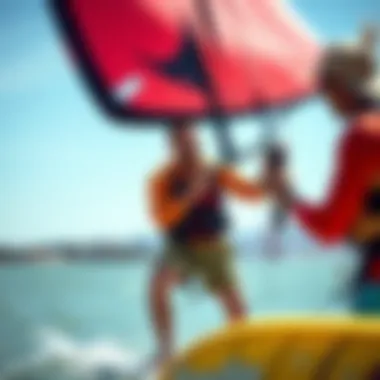
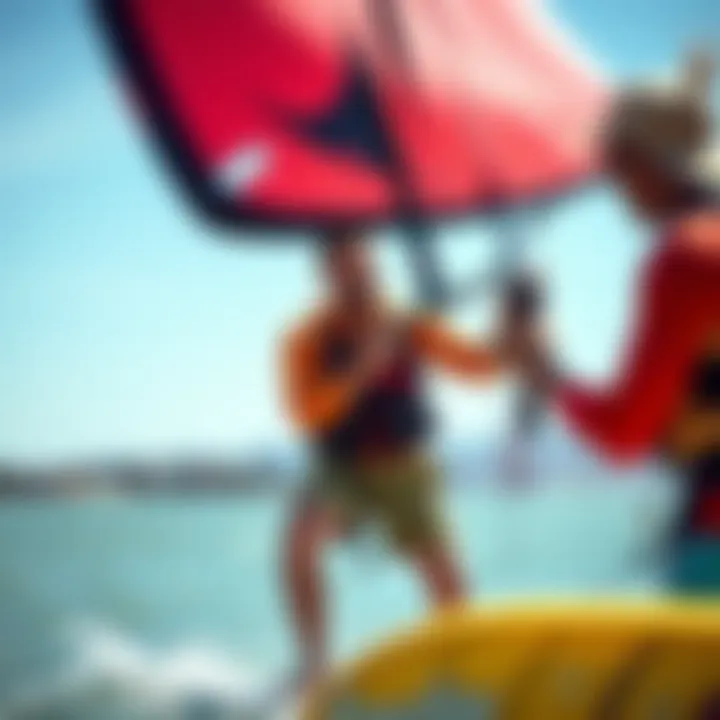
Understanding the environmental considerations in kitesurfing is not just a matter of responsibility; it’s essential for the sport’s sustainability and the health of local ecosystems. As kitesurfers enjoy the beauty of San Francisco's unique coastline and waterways, they also hold a crucial role in preserving these natural resources for the future enthusiasts. The balance between recreation and conservation is a delicate one, and grasping the specifics can lead to more informed actions on the water.
Promoting Responsible Kitesurfing Practices
To make the most of your kitesurfing experience while safeguarding the environment, it’s vital to adopt responsible practices. These include:
- Sticking to Designated Areas: Be aware of and respect areas designated for kitesurfing. This minimizes disturbances to marine life and allows for sustainable use of the waters.
- Avoiding Sensitive Habitats: Certain areas may harbor sensitive ecosystems, such as nesting sites for birds or marine habitats. It's important to keep a respectful distance.
- Minimizing Waste: Carry out what you bring in. Make sure to pack your trash and reduce the use of single-use plastics. Every little bit helps maintain the beauty of the surroundings.
- Using Eco-friendly Gear: When possible, opt for gear that is sustainable or made from recycled materials. This choice can lower your impact on the environment significantly.
Adopting these practices means you are not just a kitesurfer; you are a steward of the ocean.
"The ocean is not a place to escape, it's a place to protect."
Impact on Local Wildlife and Ecosystems
Kitesurfing can affect local wildlife and ecosystems more than many realize. When engaging in this exhilarating sport, it’s crucial to understand the implications of our presence in these environments.
- Disturbances to Marine Life: The noise and movement associated with kitesurfing can disrupt the natural behavior of marine species, particularly during sensitive periods like breeding or feeding.
- Pollution Concerns: Equipment can introduce pollutants into the water if not handled with care. From oil or fuel leaks to debris left behind, even minor negligence can have significant ecological consequences.
- Habitat Degradation: The physical impacts of kites and boards on delicate ecosystems such as seagrasses and coral reefs can lead to habitat degradation. These crucial environments are essential for countless marine organisms, and protecting them should be a priority.
Thus, responsible kitesurfing extends beyond just personal enjoyment; it’s about being mindful of your impact. By making small changes and promoting awareness, each kitesurfer can play a part in the bigger picture of environmental stewardship.
Understanding Local Conditions
Understanding local conditions is a cornerstone of enjoying and excelling in kitesurfing, particularly in a unique setting like San Francisco. This city boasts its own array of wind patterns and water conditions that can significantly affect your experience on the water. Those who live and breathe kitesurfing know that it’s not all about skill alone; knowing when and where to ride is just as crucial.
Considering aspects like wind direction, water currents, and seasonal variability allows one to strategize their sessions effectively. When conditions align with the rider's skill level, fun and safety go hand in hand. With the bay’s enticing geography and complex meteorology, a keen awareness of these local nuances can make the difference between a thrilling day and a disappointing one.
"You can't control the wind, but you can adjust your sails or in this case, your kite."
Wind Patterns and Water Conditions
In San Francisco, wind patterns are primarily influenced by the coastal geography and the local climate. The winds are typically strongest in the afternoon, ranging from 15 to 30 knots, especially during the summer months. This phenomenon, coupled with the bay’s natural funneling, leads to reliable kitesurfing conditions, making it a mecca for enthusiasts.
- Northwest Winds: The prevailing winds in the summer come from the northwest, providing consistent conditions for kitesurfing at popular spots like Crissy Field and Ocean Beach. These winds often pick up in the afternoon, offering thrilling opportunities for riders.
- Water Conditions: The bay can have varying water conditions depending on the tides. Understanding the tidal patterns is important. For instance, low tide may expose underwater hazards, while high tide can bring stronger currents.
Having insight into these wind patterns allows riders not only to choose the right days for kitesurfing but also to select the appropriate equipment for the conditions they may face.
Best Times to Kitesurf in San Francisco
Timing can be everything when it comes to kitesurfing. In San Francisco, the best times to hit the water generally align with the natural wind patterns and seasonal changes. Optimizing this knowledge allows for some prime riding opportunities.
- Summer Season: From late spring to early fall, the wind conditions are at their peak. The powerful afternoon winds and warmer temperatures create an ideal environment for kitesurfing.
- Weekdays vs. Weekends: Many riders take advantage of the lighter weekday crowds, as weekends can become quite packed, especially in popular spots.
- Tide Considerations: Paying attention to the tides is also critical. Most seasoned kitesurfers prefer to focus on times when the tide is incoming or high for better water conditions.
Embracing and understanding when to kitesurf in San Francisco not only enhances the experience but strengthens your skills as a kitesurfer. The interplay of wind, water, and timing culminates in a rewarding experience that reflects the beauty and complexity of this sport.
Safety Protocols in Kitesurfing
Safety should never be taken lightly when engaging in kitesurfing, especially in the dynamic environment of San Francisco. With its diverse weather conditions and bustling coastline, the potential for hazards is ever-present. Understanding and adhering to safety protocols enhances not just your personal experience but also contributes to the well-being of the entire kitesurfing community. When you’re suited up in the right gear and aware of the conditions around you, the likelihood of accidents diminishes significantly.
Essential Safety Gear
Before you hit the waves, equip yourself with essential safety gear that serves as your first line of defense. Some crucial items include:
- Helmet: A well-fitting, durable helmet is non-negotiable. Protects your head from impacts while navigating through turbulent waters.
- Impact Vest: Unlike the standard buoyancy vests, an impact vest specifically cushions your torso against potential falls. This is particularly important when jumping or performing tricks.
- Safety Leash: Connects you to your board so that you don’t lose it in case of a wipeout. This small accessory can save you from unnecessary rescues and is integral to securing your gear in high winds.
- Harness: Choose one that fits comfortably and offers support while allowing for freedom of movement. A proper harness reduces fatigue and enhances control.
- Wet Suit: Depending on the time of year, a wet suit may be necessary to keep your body warm in chilly waters. Make sure it allows for some flexibility.
- Emergency Whistle: A lightweight yet effective tool to signal for help or alert nearby kitesurfers in case of emergencies.
Investing in quality gear not only ensures your safety but can also enhance your overall experience on the water.
Identifying and Responding to Hazards
Being conscious of the environment and potential hazards is paramount for any kitesurfer. Here’s how to identify and respond to various risks:
- Changing Weather Conditions: Always check local forecasts before heading out. Unexpected changes in wind speed or direction can make conditions dangerous. If you notice dark clouds or suddenly shifting winds, consider calling it a day.
- Water Obstacles: Familiarize yourself with the area to avoid unmarked hazards like rocks, sandbars, or other surfers. It’s wise to refrain from attempting jumps or tricks in unfamiliar waters until you know what's lurking below.
- Crowded Areas: Tread carefully in packed spots. Maintaining a safe distance from other kitesurfers is essential. It’s important to be aware of others' movements and avoid cross-over paths to reduce the risk of collisions.
- Current and Tides: Learn about the local tidal patterns and currents. Some spots may appear inviting but hide strong currents that can pull you out to sea quickly. If you feel the tide pulling you unexpectedly, make a plan to come back to shore safely.


"An ounce of prevention is worth a pound of cure." By recognizing these hazards and having a game plan, you'll not only safeguard yourself but also set an example for fellow kitesurfers.
In summary, embracing safety protocols in kitesurfing doesn’t just protect you; it ensures a fun, responsible, and community-minded experience for everyone involved. Familiarize yourself with the essential gear and be vigilant of environmental factors. The thrill of kitesurfing is unmatched, but it’s crucial to prioritize safety for an enjoyable adventure on the waters of San Francisco.
Preparing for Your First Lesson
Preparing for your kitesurfing lesson is essential. It can be the difference between a smooth ride on the waves and an experience filled with apprehension. First-timers often wear jitters like a badge of honor, but understanding what to expect can lessen those initial nerves. Here’s what you need to know to sail smoothly into your first session.
What to Expect During Your First Session
Your first day on the water is bound to be buzzing with excitement and can feel a bit overwhelming too. Most schools will start with a safety briefing, where instructors outline the basic rules of the water and gear handling. During this intro, they may cover:
- Kite Control: Learning how to hold and steer the kite is paramount. Instructors usually guide you on how to set up the kite, and how to launch and land it safely.
- Water Safety: The beach or waterway will hold its share of nuances, such as currents and tide changes. Knowing how to navigate these factors is crucial.
- Gear Familiarization: Getting to grips with the equipment can be a daunting task but is vital. Expect a deep dive into the kite, lines, harness, and board.
Once you get past the essentials, it’s time to hit the water. Your instructor may take you through body dragging, which is essentially the art of controlling the kite while in the water – an exciting and liberating introduction to kitesurfing. If the wind is right, you might even get to stand up briefly, which feels like reaching for the sky.
Mental and Physical Preparation
Preparing your mind and body is just as important as gearing up with the right equipment. Kitesurfing requires a mixed bag of physical fitness and mental readiness. Here are some key points to consider:
- Physical Conditioning: Kitesurfing engages several muscle groups. Core strength, especially, plays a significant role in maintaining balance on the board. Strengthening your core before lessons can make a big difference.
- Flexibility: Stretching is vital. When your body is limber, you’re less likely to pull a muscle while maneuvering. Simple stretches before your lesson can keep you agile.
- Mindset: Approach your first lesson with a mindset geared towards learning. This means being open to instruction, embracing mistakes, and all the small triumphs that come with them. Complex maneuvers won’t come overnight, and that’s perfectly okay.
"Remember, every expert was once a beginner. Your first session is merely the beginning of a thrilling journey."
Ultimately, kitesurfing is not just about physical prowess; mental fortitude holds equal weight. Staying calm can help you process what you learn and will keep you enjoying the experience.
By arming yourself with knowledge and preparing both your mind and body, you're setting the stage for a fulfilling introduction to kitesurfing. Whether you glide through the air or focus on mastering kite control, each experience will contribute to your growth as a kiteboarder.
After Your Lessons: Continuing Your Kitesurfing Journey
Once you've completed your kitesurfing lessons, the real adventure begins. This stage is crucial in molding not just your skills as a rider but also your connection to the kitesurfing community. Engaging in continuous practice and finding ways to deepen your understanding of the sport can greatly enhance both your confidence and enjoyment.
It’s not merely about mastering the technical skills; it's about embracing the lifestyle that comes with kitesurfing. This section will focus on two pivotal aspects: building your skills and confidence, and embracing the local communities that foster a sense of belonging and support.
Building Skills and Confidence
Continuing your kitesurfing journey is akin to a fine wine getting better with age. After the initial lessons, you'll find that practice is central to your growth. As you hit the water more frequently, you begin to understand your limits and push beyond them. Every session presents a new opportunity to get comfortable with different conditions, whether it be choppy waters, gusty winds, or varying tides.
Building skills goes hand-in-hand with boosting your confidence. Here are some points to consider as you continue refining your kitesurfing abilities:
- Practice Regularly: Consistency is key. Try to hit the water at least once a week to keep things fresh and continue developing. If you slack off, it’s easy to lose what you’ve learned.
- Set Achievable Goals: Maybe you want to master a certain trick or ride in a different area. Setting and achieving small goals can boost your confidence.
- Evaluate Your Progress: Keep a journal of your kite sessions. Noting down what went well and what didn’t can give clarity on areas to focus on in the future.
- Video Analyses: Record your sessions if possible, and review them. This can unveil areas of improvement that you may not notice while on the water.
"The sea is in my blood, and with every breeze, I feel a tad more like a captain of my own ship; no waves too high, no winds too fierce."
Remember, confidence doesn’t come overnight. It evolves as you tackle challenges and make mistakes; these experiences shape who you are as a kiter.
Joining Local Communities and Groups
Being part of a kitesurfing community can transform your experience from solitary to something truly rewarding. You’ll find encouragement, advice, and friendships among people who share your passion. Local communities are not just about a shared interest; they offer rich resources that can enhance both your skills and kitesurfing lifespan.
Here’s how to get involved:
- Attend Local Events: Look for kitesurfing competitions, workshops, or beach clean-ups. These gatherings provide excellent opportunities for networking and learning.
- Join Online Forums: Websites like Reddit have dedicated kitesurfing communities where you can ask questions, share experiences, or even find a riding buddy. Check out threads on relevant subreddits like r/kitesurfing.
- Social Media Groups: Platforms like Facebook host multiple kitesurfing groups. Joining these will help you stay updated on local happenings, promotions, and community tips.
- Find a Mentor: If you feel the need for more advanced instruction, seek out seasoned riders who can provide tips and guidance based on their experiences.
Participating actively in these groups not only enhances your knowledge but also provides a sense of belonging. You’ll learn about uncharted beach spots, promotional deals on gear, and even safety tips that can come handy at any moment.
Epilogue: Embracing the Kitesurfing Lifestyle
Kitesurfing, particularly in a vibrant place like San Francisco, is not just a sport; it's a lifestyle that melds adventure, community, and personal growth. When one engages in this exhilarating water activity, it transcends the mere act of riding the waves. Instead, it becomes an integral part of one’s being, intertwining with social connections and environmental consciousness.
The Broader Impact of Kitesurfing on Local Culture
Kitesurfing’s influence on local culture can be observed in several layers. First and foremost, it creates a community of enthusiasts who share a passion for both the sport and the stunning backdrop of San Francisco.
There's often a sense of comradery among kiteboarders; whether you're a pro or just starting out, the beach is filled with individuals willing to lend a helping hand or share tips under the sun.
Moreover, local businesses have felt the impact as well. Shops selling kiteboarding gear and apparel, surf schools offering lessons, and cafes near popular kitesurfing spots thrive due to the influx of visitors and locals indulging in this pursuit. Participating in the kitesurfing scene is akin to joining a larger family where everyone knows the best spots and conditions for riding. This environment nurtures collaboration and mutual support, fostering a vibrant community spirit.
Aside from its social fabric, kitesurfing also urges individuals to appreciate and respect the natural beauty of San Francisco’s waters. The active engagement with the environment often sparks conversations about conservation and sustainability among practitioners. Remembering the powerful forces of nature, riders tend to develop a deeper respect for the ocean and its ecosystems.
In summary, embracing the kitesurfing lifestyle in San Francisco has multifaceted benefits. From building friendships and supporting the local economy to promoting environmental stewardship, kitesurfing weaves a rich tapestry that enhances not only personal lives but also the broader cultural landscape. By making a commitment to this sport, individuals become part of a movement that celebrates both thrill and mindfulness, ensuring that the joy of kitesurfing continues to thrive for future generations.




